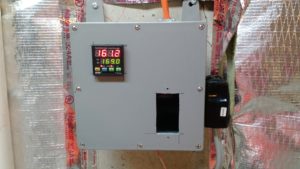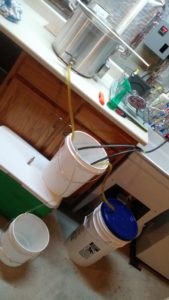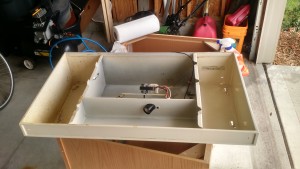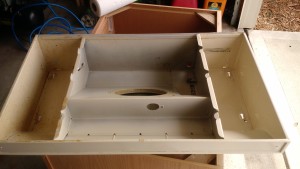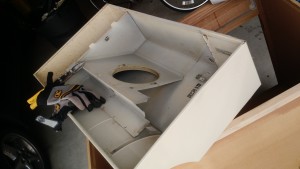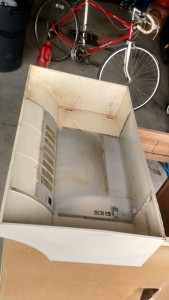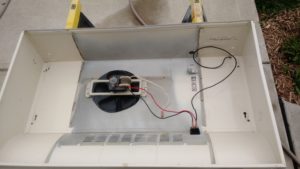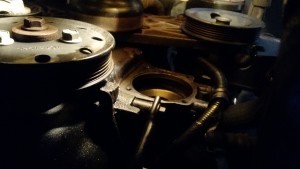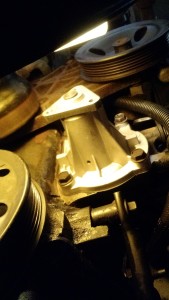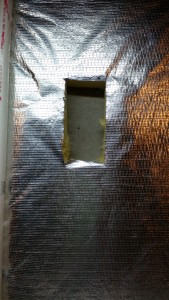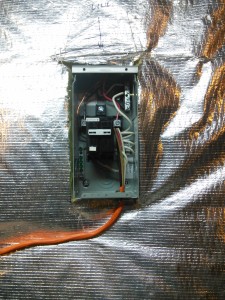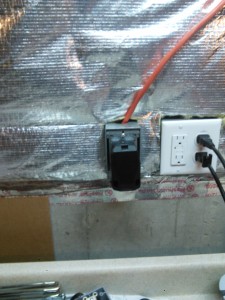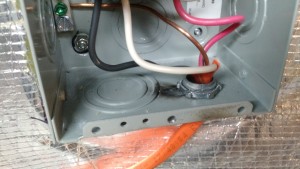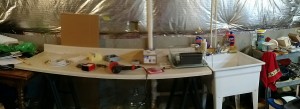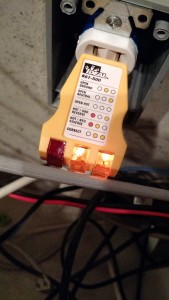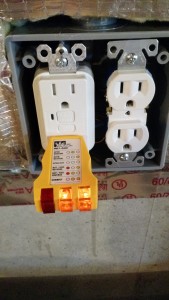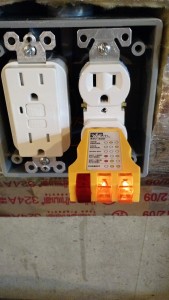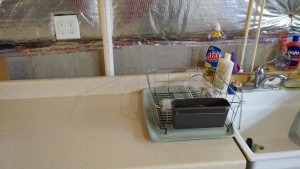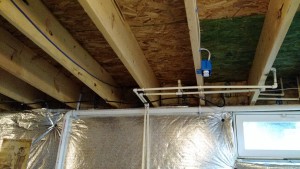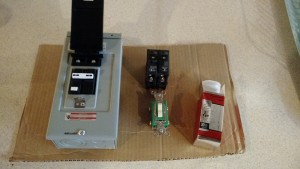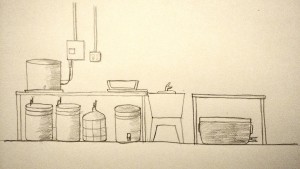Tag Archive: electric brewery
Another IPA Brew Day
So I decided later than usual on a Saturday to brew. This is a brew that I wanted to do the prior weekend, but my home AC was on the fritz and adding a bunch of humidity to it would not have been a very smart move.
This was an interesting brew day for two reasons. A large portion of the brew day was spent thinking that I would be preparing to brew the following day. I built an electric panel to fix the dangerous setup I had previously.
The thing is, I didn’t have the plug on the cord from the boiler ready. Once I did that, I added water and started things up. Then I went to work on preparing the mash tun. In my last post, I had the stuck sparge from Hell. I did NOT want that happening again. I added some plumbing solder in some strategic places and scrubbed down the copper. At that point (and after messing up and fixing solder joints twice, and since leaks don’t really matter here the mess ups were pretty important to fix), I decided to go ‘all in’ and start mashing.
I love problems that fix themselves!
This brew day had one minor mess up – for my IPA, I have hops at first wort (in the kettle), 15, 5, knockout, and dry. I did first wort, 15, 10, and knockout. Oops. It also had one issue that I thought would be a huge problem – my sparge water kept heating even after the PID said things were off. I didn’t notice until the water hit 205º F, and the heat was still on despite the output light on the PID controller not being on. So I unplugged the boiler to keep the water from boiling and let it cool. Later, when it was time to heat the water back up to sparge temperatures, I plugged the boiler back in and let it heat back up. And it worked correctly. And it worked correctly through the entire boil, too. I love problems that fix themselves!
They leak
Chilling had been an issue in the past, and I still reign supreme at having the most fucked up chilling schemes. This one isn’t much different. I bought a plate chiller on Amazon a few weeks ago. The water inlets and outlets were standard hose fittings. My house is six years old, and the cheap washing machine lines were something that was on the list of things to replace. I decided to purchase new stainless steel lines for the washing machine and use the old lines for the plate chiller.
They leak. Somehow in the process of unhooking them from the back of the washing machine and the wall and putting them on the plate chiller, they decided to leak. And these weren’t leaks that could be fixed by torquing down the connectors or using pipe tape (which is unnecessary on these connectors). And I made sure the O-rings were in the hose connectors.
So I did what any sane person would do. Since I didn’t have enough hose to set the plate chiller in the sink (that would have been optimal), I put the chiller in a bucket. Which started to fill. So to avoid flooding part of my basement, I used a small hose to siphon the leaking water out of the main bucket into another so I could dump water without moving the plate chiller around.
So on the shopping list is two new hoses. Because had I had not-leaking hoses, the plate chiller would have worked very well. And even allowing a lot of the trub go through was okay (I use pellet hops). I’m not sure what temperature I got things down to. Put the ale pail into the fermentation chamber and set it to chill at about 6:30. I ended up pitching the yeast at midnight or so.
The Recipe
The recipe has changed a little. I wanted it a little less malty and a little more crisp.
Recipe Details
| Batch Size | Boil Time | IBU | SRM | Est. OG | Est. FG | ABV |
|---|---|---|---|---|---|---|
| 5 gal | 60 min | 71.4 IBUs | 5.4 SRM | 1.070 | 1.013 | 7.6 % |
| Actuals | 1.051 | 1.01 | 5.4 % | |||
Style Details
| Name | Cat. | OG Range | FG Range | IBU | SRM | Carb | ABV |
|---|---|---|---|---|---|---|---|
| American IPA | 14 B | 1.056 - 1.075 | 1.01 - 1.018 | 40 - 70 | 6 - 15 | 2.2 - 2.7 | 5.5 - 7.5 % |
Fermentables
| Name | Amount | % |
|---|---|---|
| Pale Malt (2 Row) US | 7 lbs | 50 |
| Vienna Malt | 6 lbs | 42.86 |
| Cara-Pils/Dextrine | 1 lbs | 7.14 |
Hops
| Name | Amount | Time | Use | Form | Alpha % |
|---|---|---|---|---|---|
| Cascade | 2 oz | 15 min | First Wort | Pellet | 6.6 |
| Cascade | 0.5 oz | 15 min | Boil | Pellet | 6.6 |
| Citra | 0.5 oz | 15 min | Boil | Pellet | 12 |
| Galaxy | 0.5 oz | 15 min | Boil | Pellet | 11 |
| Cascade | 0.5 oz | 5 min | Boil | Pellet | 6.6 |
| Citra | 0.5 oz | 5 min | Boil | Pellet | 12 |
| Galaxy | 0.5 oz | 5 min | Boil | Pellet | 11 |
| Cascade | 1 oz | 15 min | Aroma | Pellet | 6.6 |
| Citra | 1 oz | 15 min | Aroma | Pellet | 12 |
| Galaxy | 1 oz | 15 min | Aroma | Pellet | 11 |
| Cascade | 1 oz | 7 days | Dry Hop | Pellet | 6.6 |
| Citra | 1 oz | 7 days | Dry Hop | Pellet | 11 |
| Galaxy | 1 oz | 7 days | Dry Hop | Pellet | 11 |
Miscs
| Name | Amount | Time | Use | Type |
|---|---|---|---|---|
| Irish Moss | 0.25 tsp | 15 min | Boil | Fining |
Yeast
| Name | Lab | Attenuation | Temperature |
|---|---|---|---|
| American Ale (1056) | Wyeast Labs | 75% | 60°F - 72°F |
Mash
| Step | Temperature | Time |
|---|---|---|
| Mash In | 148°F | 60 min |
Now the wait. One week (as of time of writing) to add dry hops, and one week to absorb. Then bottling and another week to two weeks to wait. I WISH IT WAS DONE ALREADY.
Cheers!
Old Range Hood Turned Into a Brewery Exhaust Hood
Since I brew in my basement, it’s pretty important to exhaust the vapor from the wort outside the house. When it’s any temperature that isn’t between 50 and 65 degrees, opening a window isn’t the greatest way.
A friend was remodeling his kitchen and gave me a sink base cabinet (which will make it’s way down into the brewery) and his old range hood. the range hood was one that recirculates the air (as opposed to exhausting it), so it’s actually kinda useless. But with some modifications, it can exhaust the air.
One note about this is that safety is paramount. Sharp metal edges can cut like a broken glass carboy.
After this, I went to pull my truck back into the garage and noticed a bunch of coolant under my truck and trailing into the garage. The water pump blew.
Cheers!
The Wortsplosion and Lessons Learned
The title of this, coupled with last week’s post is chilling.
Brew day was not without hitches and major issues. It started with me not hitting my mash temp. The grain was cooler than I thought, so after making adjustments in BeerSmith, I set the temperature controller for the new temperature. I learned something…
Lesson 1: before believing that the temperature is correct, stir the HLT
I added water to bring the temperature up, but probably only partially successfully. My gravity was lower than I wanted by sparge, so I actually re-circulated the wort through the sparge again.
Boil went off mostly without a hitch, but I learned something else…
Lesson 2: it is possible to have too much of a boil
I didn’t get a mess (yet), but the wave caused by the over-active boil was a little scary. I found that 212.6F was a pretty good boil without causing a wave.
Lesson 3: Ventilation is important
The condensation caused minor issues, but allowed to go too long, this could become dangerous (mold?). Better work on a ventilation system. In the meantime, I’m running a dehumidifier.
Lesson 4: Barbed connectors shouldn’t be connected to pumps used for hot wort
Yeah, this is where the wortsplosion happened. I have a barbed connector going from my boil tun to and from the pump, to and from an immersion chiller in a bucket of ice water (I’m using it backwards, the heating element is in the way of using it normally, yes I cleaned it!).
Lesson 5: Wortsplosions are bad, especially where electricity is involved
Wort spraying everywhere means that it got on everything.
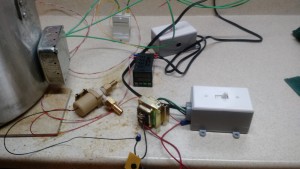
The pic doesn’t do it justice – there was wort on the side of the boil tun, the switches, the transformer, the PID controller, and me.
Somehow I managed to not get electrocuted in all this. The switches are not waterproof, and 24V AC and DC wiring is exposed. Everything had to be disassembled for cleaning.
One thing I did not own is a mop. I had to run out and get one, and I used some extra-strength purple Simple Green cleaner I had in my garage to remove the half-dried wort from the floor.
Total wort loss was about 3 quarts. 1 quart in my jeans, the rest to the floor. Not a total loss.
I did end up hitting about 70% efficiency, which I partly blame on adding the grain to the mash water in the cooler as opposed to the other way around. I also drained and sparged much slower.
Anyway, I’m going to consider buying a plate chiller. And new fittings (fuck the barbed hose fittings). Probably cam fittings.
The Saison that I brewed is fermenting.
Cheers!
Dangerous Electric Boil Kettle DONE!
I had some free time over the weekend and was able to work on the brew kettle. As of Saturday afternoon, I was boiling water and if it wasn’t for having a few things to do I would have probably ran over to my LHBS and got a few pounds of malt and hops.
The things I did dangerously was that I used all green wire (the standard AC convention is red or black for hot, white for neutral, and green for ground). Also, I have no enclosure around all that power. I also do not have a way to disconnect this from power (other than a breaker, which is currently switched off since I’m not brewing anything).
While I was at it, I replaced my valve with a non-leaking valve (my previous valve was actually for a compression fitting, so it leaked). There is a remaining issue – I have to replace the fitting on the thermocouple because right now I have a compression nut (which leaves a place for bacteria to sit and harvest).
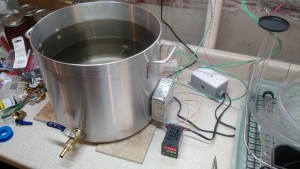
This is the setup. Not perfect, but it works. The switch is for the PID controller (the black box). The SSR is hiding behind the boiler.
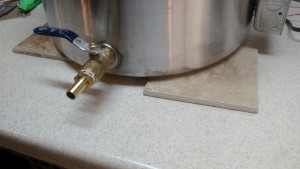
This is my counter protection – 3 6″x6″ ceramic tiles. I don’t think the kettle would damage my Formica countertop, but I don’t want to find out if I’m wrong.
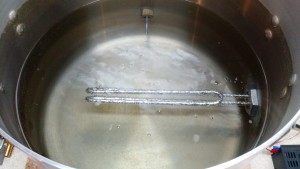
This is the element running and boiling water.
Other Happenings
My cousin was selling a small freezer that would be perfect for us and would replace my current chest freezer with a small upright (and replace a non-energy-star freezer with one that is). Initially I was thinking KEGERATOR!, but after a night’s sleep I thought it might be better to do some fermentation temperature control. That means eventually I will make a schwarzbier, possibly a kolsch, and probably a bock beer early next year.
Cheers!
Brewery Upgrade Phase 2
In the upgrade process, phase 2 is running the 240V line to run the heating elements. This is a hard post to make exciting, because it’s basically all about a wire. And at one time after reading about the death of craft beer on some linkbaitey website (damn you Gose!!! :-D), I thought that I should only make posts that are informative or truly funny, and occasionally respectfully opinionated.
This post is about a boring orange wire.
IMPORTANT NOTE: NOTHING IN THIS IS ADVICE OR A HOW-TO. The voltages involved with an electric brewery are extremely dangerous, and doing things wrong can result in FIRE or DEATH (and it will hurt like Hell the entire time you are dying).
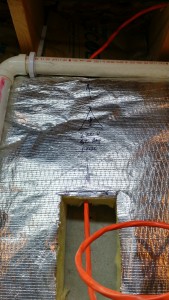
A boring hole with a wire. I couldn’t get conduit behind the drainpipe above, and that drainpipe is NOT getting moved, so I wrote on the insulation that there is a wire there.
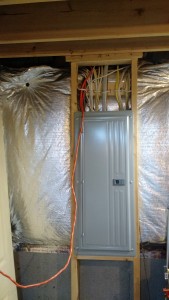
And… a wire. It’s pulled down near the circuit breaker panel in preparation to be run in the panel to a breaker.
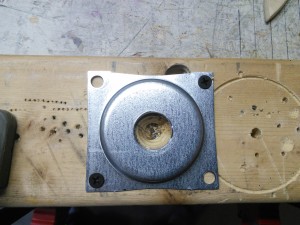
I sometimes have good ideas. Like bolting this piece down to a scrap piece of 2×4 to drill it for a cable connector.
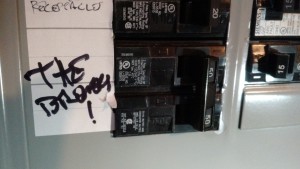
Around this point, I shut off the power and installed the 50-amp breaker.
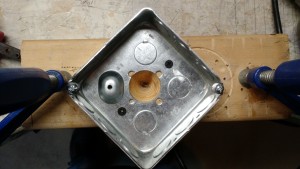
Drilling the enclosure for the side of the kettle.
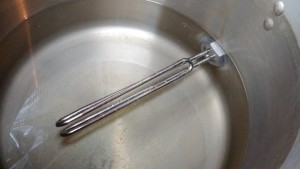
Installed heating element. This took three or four tries to get it installed, and ultimately the wrong washer was the one that came with it and the correct one was a red 1 11/16 o-ring I bought from Amazon.
After this, I decided to turn things on. Unfortunately, I was greeted with a shit ton of sparks.
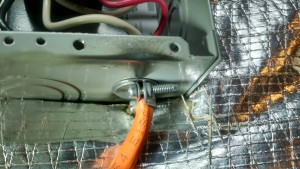
Bottom side of sparks.
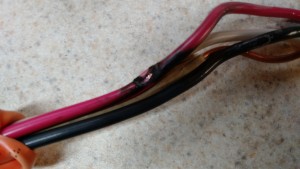
After shutting stuff down and looking into WHY I had a little explosion, I found that I must have pulled the cable too tight and sliced into one of the hot wires. When it connected to ground… BOOM.
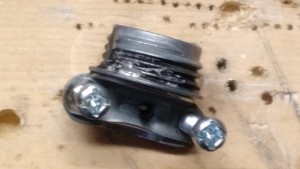
This is the strain relief that the cable was sliced through. This did come right out, fortunately, as the heat from the arcing was enough to do some damage to the threads. Had it been longer, it could have welded in place.
While a large part of this post was quite boring (seriously, it’s a wire!), I’m really excited about it. Not the wire (even I think the wire’s pretty darn boring), what will happen when I get the rest of the stuff wired in and I can brew beer in the basement.
Cheers!
Brewery Upgrade Phase 1
I did the first phase of upgrades. This wasn’t a whole lot of work, but after spending quite some time at the hardware store, it was enough to cap off the rest of a day.
So the first part was an outlet somewhere near the brewing area. I’ve never actually needed an outlet for brewing, but the counter sometimes serves other purposes (my food dehydrator, for example), so having some outlet space is useful. Plus, if I want to plug in a radio, my phone, or something like that, I don’t want to run an extension cord across the basement. Safety first and all that!
DISCLAIMER: I am not an electrician. What I’m documenting here is a result of research mixed with a little bit of theoretical knowledge and some experience. This is not a guide or how-to on how to do this.
So extending the outlet isn’t difficult. Black to brass, silver to silver, and bare to bare. Running it is a pain, but hooking up wires is easy. Testing is easy.
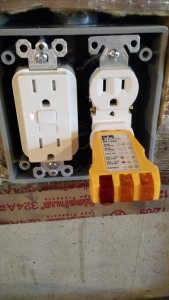
Sometimes twice (note the GFCI light is on, I pressed the test button and wanted to ensure that the other outlet was actually protected)
That was the first part of the improvements. The second part was another outlet, but this one was for a light. I tied it into a light socket nearby.
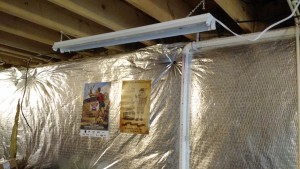
The finished light, sans bulbs (they didn’t come with the kit). This will operate with the switch to turn on all the basement lights.
So that’s phase 1.
Stay tuned for phase 2
Cheers!
New Brewing Setup Plan
After the last beast of a brew day, I want to fix my setup to make the next brew (soon, hopefully) easier. I don’t need all the fancy-pants pumps and stuff, but I do need a good way to heat water quickly and safely. Convenience is pretty important to me as well, so I’m not going to brew in my garage (no sink and poor electrical and poor lighting).
So I drew (literally) my plan.
This is a plan in four phases, and since I’m looking for content, I’m going to have a post for each phase.
Phase 1: 120v Upgrades This is minor upgrades to the electric at my brewing area including an outlet at the brewing station and a better light.
Phase 2: 240v Wiring This is the major part of the wiring. I’m not afraid of electricity at all (I’ve been shocked a few times), but I do take care (which is probably why those shocks weren’t enough to kill me).
Phase 3: Control Box Since I don’t have hundreds or thousands of dollars sitting around, I’m making my control box myself.
Phase 4: Finish Up and Testing I’m not doing all this stuff for my health! There’s a few things that will have to be added in, like a pump. Realistically, I’m going to need to another kettle, too, but that will be a while.
Cheers!
